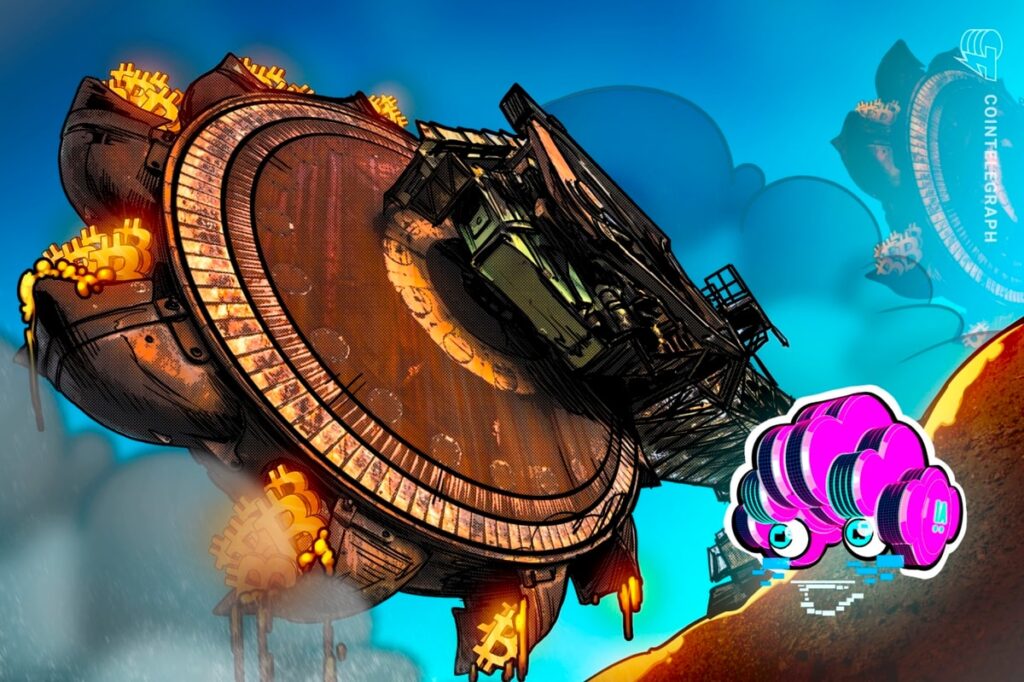
Bitcoin miners turned to the rising AI trend ahead of the 2024 halving, which cut block rewards to 3.125 Bitcoin (BTC).
Some just dipped their toes in, while others dove deeper, repurposing rigs, raising credit and signing billion-dollar deals.
But how’s that spinoff working out in reality? In some instances, the move has been a lifeline that generates much-needed revenue as their Bitcoin earnings dropped. For others, it’s more of a safety net that can cushion future halving shocks.
Here’s a look at what’s happened to the biggest crypto mining firms since their AI pivot.
AI pivot saved this Bitcoin miner
Core Scientific is among the biggest revival stories for Bitcoin miners whose AI pivot saved its struggling business.
The company filed for Chapter 11 bankruptcy in late 2022. It emerged in early 2024 to relist on the Nasdaq, then shifted from a pure Bitcoin miner to a colocation service provider by leasing out data centers to AI firms. It signed a 12-year, $3.5-billion deal with CoreWeave in June 2024 to host CoreWeave’s high-performance computing (HPC) operations.
Core Scientific reported its Q1 revenue fell to $79.5 million, down from $179.3 million a year earlier. It cited the Bitcoin halving reward slash and the operational shift to HPC hosting as the primary reasons for the revenue drop. A surge in Bitcoin’s price since the halving has offset some of the losses.
Related: Bitcoin Knots gain ground: Will a chain split kill BTC price?
In late June 2025, CoreWeave resumed talks to acquire Core Scientific, following a failed $1-billion buyout attempt in 2024. News of the renewed negotiations sent Core Scientific’s stock soaring.
AI remains a side hustle for most Bitcoin miners
Hut 8’s AI ambitions took real shape in September 2024, when the company formally launched its GPU-as-a-Service offering through a new subsidiary, Highrise AI.
The pivot saw Hut 8 deploy over 1,000 Nvidia H100 GPUs — specialized chips widely used for training and running AI models — to drive its cloud-based AI compute services. The launch came with a five-year fixed-payment and revenue-share deal as revenues for Bitcoin miners tightened following the April 2024 halving event.
By Q1 2025, the company’s Bitcoin mining had produced 167 BTC, down from 716 BTC the year before. Though the company posted a quarterly net loss of $134.3 million, its CEO, Asher Genoot, said its financial performance was a result of deliberate investments that resulted in a 79% increase in its hashrate. It also holds 10,273 BTC, which is the ninth-largest publicly listed corporate Bitcoin treasury.
AI remains a small part of Hut 8’s business model as the company continues to expand its Bitcoin business. Most recently, American Bitcoin, a majority-owned subsidiary of Hut 8, announced a $220-million raise to purchase Bitcoin mining equipment. Sons of US President Donald Trump are among the founders of American Bitcoin, of which Hut 8 acquired a majority stake in the firm in late March.
AI is a growing revenue pie for these Bitcoin miners
Bitcoin miners like Iren and Hive are starting to see meaningful revenue from AI, even if mining still dominates their books.
In early 2024, Australian miner Iren (formerly Iris Energy) began purchasing Nvidia GPUs. By February, it had signed its first AI contract powered by 248 GPUs. As of mid-2025, the company has deployed around 4,300 GPUs. In Q3 fiscal year 2025 (ended March 31), Iren mined 1,514 BTC, up from 1,232 BTC the previous quarter.
Meanwhile, AI cloud revenue climbed 33% to $3.6 million. The company is also preparing a liquid-cooled AI data center in Texas and a purpose-built site in British Columbia, Canada, capable of housing up to 20,000 GPUs. However, a class-action lawsuit filed in October 2024 alleged Iren misled investors about the readiness of its Texas facility.
Related: Bitcoin hashrate down 15%, 26 firms add BTC to balance sheets: June in charts
Hive began its AI shift in mid-2023 with a rebrand from Hive Blockchain and a focus on Nvidia-powered compute clusters. After small-scale early deployments, Hive invested $30 million in December 2024 to roll out GPUs in Quebec, Canada. By mid-2025, it had over 5,000 units deployed.
For its 2025 fiscal year, Hive generated $115.3 million in revenue, with $10.1 million — triple the prior year — from AI and HPC hosting. That now makes up nearly 9% of total revenue.
Top Bitcoin miner treasuries aren’t the best performers
Riot Platforms and MARA Holdings are two of the largest names in Bitcoin mining, but both are now laying the groundwork for a post-mining future.
Riot began exploring AI and HPC workloads in early 2025, launching a formal evaluation to convert up to 600 megawatts at its Corsicana, Texas facility into high-performance infrastructure. The shift came with a pause on further Bitcoin mining buildout at the site. Riot hasn’t signed any major AI contracts yet, but its Corsicana site — spanning 355 acres and eventually capable of handling 1 gigawatt of power — positions it well to attract hyperscaler clients in the future.
Riot remains financially strong in Bitcoin. In Q1 2025, it mined 1,530 BTC, generating $142.9 million in mining revenue — double its Q1 2024 revenue of $71.4 million. Riot attributed the gain to higher Bitcoin prices and increased operational hashrate. It also holds 19,225 BTC, making it the fourth-largest corporate Bitcoin holder globally.
MARA holds the largest Bitcoin treasury among miners and is second only to MicroStrategy among all public companies with 50,000 BTC.
In March 2024, MARA revealed its MARA 2PIC700, an immersion cooling system designed for dense compute workloads, including AI and crypto mining. By mid-2024, the firm rebranded its broader strategy as an “edge computing” play.
By early 2025, MARA began piloting two HPC test sites, each handling around 30 megawatts using its 2PIC700 cooling system.
The pivot hasn’t yet translated into major contracts or recurring cash flows for both Bitcoin producers, but their Bitcoin balance shows why they’re not desperate to diversify AI expansion.
The Bitcoin miner that ditched AI
While many Bitcoin mining firms are leaning into AI and high-performance computing, ASIC manufacturer Canaan is heading in the opposite direction. In July 2025, the company announced it was shutting down its AI chip division.
With just 2.1% of the global ASIC market, Canaan remains a small player compared to Bitmain or MicroBT.
By focusing squarely on mining hardware and pursuing long-term resilience in North America, it’s carving a distinct path in a sector otherwise enamored with AI.
Magazine: Fake JD stablecoins, scammers impersonate Solana devs: Asia Express





